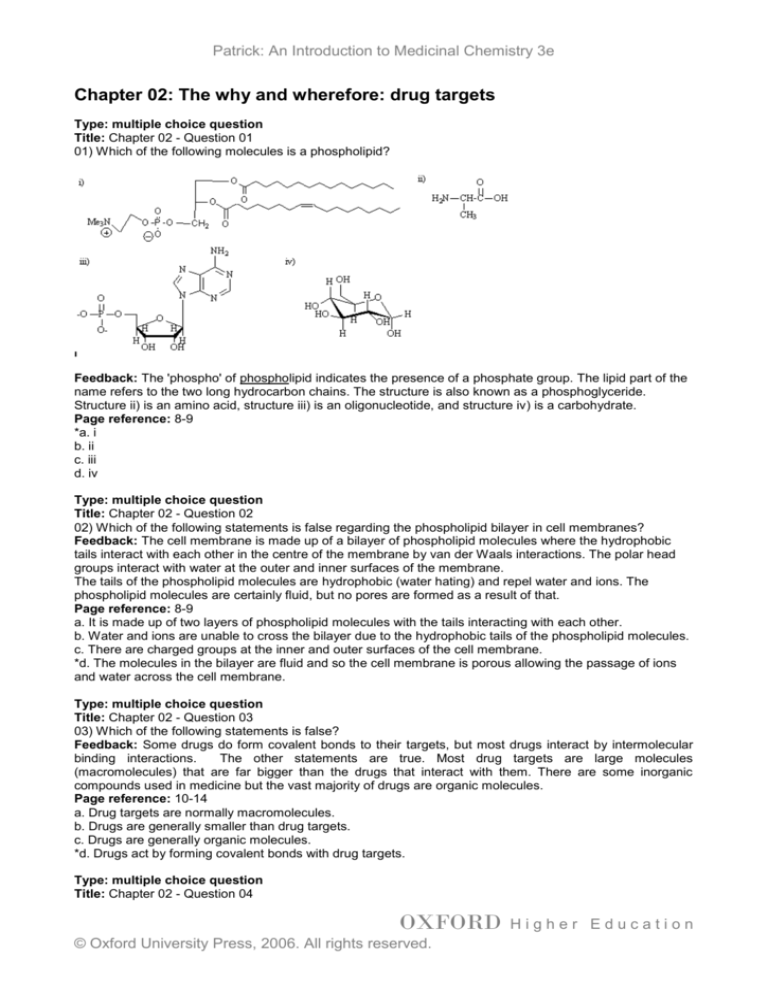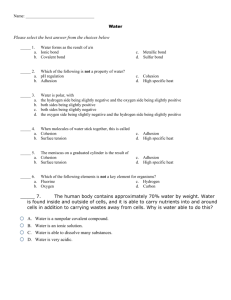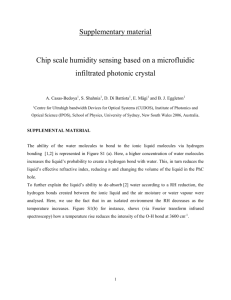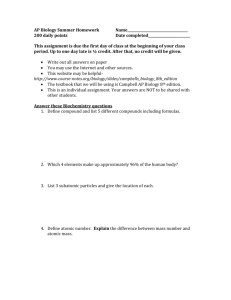
Patrick: An Introduction to Medicinal Chemistry 3e
Chapter 02: The why and wherefore: drug targets
Type: multiple choice question
Title: Chapter 02 - Question 01
01) Which of the following molecules is a phospholipid?
Feedback: The 'phospho' of phospholipid indicates the presence of a phosphate group. The lipid part of the
name refers to the two long hydrocarbon chains. The structure is also known as a phosphoglyceride.
Structure ii) is an amino acid, structure iii) is an oligonucleotide, and structure iv) is a carbohydrate.
Page reference: 8-9
*a. i
b. ii
c. iii
d. iv
Type: multiple choice question
Title: Chapter 02 - Question 02
02) Which of the following statements is false regarding the phospholipid bilayer in cell membranes?
Feedback: The cell membrane is made up of a bilayer of phospholipid molecules where the hydrophobic
tails interact with each other in the centre of the membrane by van der Waals interactions. The polar head
groups interact with water at the outer and inner surfaces of the membrane.
The tails of the phospholipid molecules are hydrophobic (water hating) and repel water and ions. The
phospholipid molecules are certainly fluid, but no pores are formed as a result of that.
Page reference: 8-9
a. It is made up of two layers of phospholipid molecules with the tails interacting with each other.
b. Water and ions are unable to cross the bilayer due to the hydrophobic tails of the phospholipid molecules.
c. There are charged groups at the inner and outer surfaces of the cell membrane.
*d. The molecules in the bilayer are fluid and so the cell membrane is porous allowing the passage of ions
and water across the cell membrane.
Type: multiple choice question
Title: Chapter 02 - Question 03
03) Which of the following statements is false?
Feedback: Some drugs do form covalent bonds to their targets, but most drugs interact by intermolecular
binding interactions.
The other statements are true. Most drug targets are large molecules
(macromolecules) that are far bigger than the drugs that interact with them. There are some inorganic
compounds used in medicine but the vast majority of drugs are organic molecules.
Page reference: 10-14
a. Drug targets are normally macromolecules.
b. Drugs are generally smaller than drug targets.
c. Drugs are generally organic molecules.
*d. Drugs act by forming covalent bonds with drug targets.
Type: multiple choice question
Title: Chapter 02 - Question 04
OXFORD
© Oxford University Press, 2006. All rights reserved.
Higher Education
Patrick: An Introduction to Medicinal Chemistry 3e
04) Which of the following statements is false with respect to a binding site?
Feedback: The binding site is normally a hydrophobic hollow or cleft on the surface of a macromolecular
target. In the binding site, there are functional groups and regions that form binding interactions with
complementary groups on a drug.
Page reference: 9
a. It is part of a macromolecule that acts as a drug target.
b. It contains binding groups.
c. It is normally a hollow or cleft on the surface of the drug target.
*d. It is usually hydrophilic in nature.
Type: matching question
Title: Chapter 02 - Question 05
05) Consider the molecule in blue bound to a binding site and identify the binding interactions (i-iv) shown in
red.
Feedback: Van der Waals interactions take place between regions of molecules consisting solely of carbon
and hydrogen atoms. Ionic bonds occur between charges of opposite sign. Hydrogen bonds occur between
a molecule acting as a hydrogen bond donor (RXH; where X is normally oxygen or nitrogen), and a molecule
acting as hydrogen bond acceptor where a heteroatom is present (normally oxygen or nitrogen).
Page reference: 9-10
a. i = Van der Waals interactions
b. ii = Ionic bond
c. iii = Hydrogen bond (1) d. iv = Hydrogen bond (2)
Type: matching question
Title: Chapter 02 - Question 06
06) Identify the binding interactions that might be possible at the specified positions of the following drug:
Feedback: Van der Waals interactions take place between molecular regions consisting solely of carbon
and hydrogen atoms; for example alkyl groups or aromatic rings. Ionic bonds occur between charges of
opposite sign. Hydrogen bonds occur between a molecule acting as hydrogen bond donor (RXH; where X is
normally oxygen or nitrogen), and a molecule acting as hydrogen bond acceptor where a heteroatom is
present (normally oxygen of nitrogen).
Page reference: 9-10
a. i = Hydrogen bond donor
OXFORD
© Oxford University Press, 2006. All rights reserved.
Higher Education
Patrick: An Introduction to Medicinal Chemistry 3e
b. ii = Van der Waals interactions
c. iii = Hydrogen bond acceptor
d. iv = Ionic interactions
Type: matching question
Title: Chapter 02 - Question 07
07) Identify the binding interactions that might be possible at the specified positions of the following drug.
Feedback: Van der Waals interactions take place between molecular regions consisting solely of carbon
and hydrogen atoms; for example alkyl groups or aromatic rings. Ionic bonds occur between charges of
opposite sign. Hydrogen bonds occur between a molecule acting as hydrogen bond donor (RXH; where X is
normally oxygen or nitrogen), and a molecule acting as hydrogen bond acceptor where a heteroatom is
present (normally oxygen of nitrogen).
Page reference: 9-10
a. i = Hydrogen bond acceptor
b. ii = Van der Waals interactions
c. iii = Ionic interactions
d. iv = Hydrogen bond donor
Type: matching question
Title: Chapter 02 - Question 08
08) Identify the binding interactions that might be possible at the specified positions of the following drug.
Feedback: Van der Waals interactions take place between molecular regions consisting solely of carbon
and hydrogen atoms; for example alkyl groups or aromatic rings. Ionic bonds occur between charges of
opposite sign. Hydrogen bonds occur between a molecule acting as hydrogen bond donor (RXH; where X is
normally oxygen or nitrogen), and a molecule acting as hydrogen bond acceptor where a heteroatom is
present (normally oxygen of nitrogen).
Page reference: 9-10
a. i = Ionic interactions
b. ii = Hydrogen bond donor
c. iii = Van der Waals interactions
d. iv = Hydrogen bond acceptor
Type: matching question
Title: Chapter 02 - Question 09
OXFORD
© Oxford University Press, 2006. All rights reserved.
Higher Education
Patrick: An Introduction to Medicinal Chemistry 3e
09) Identify the binding interactions that might be possible at the specified positions of the following drug.
Feedback: Van der Waals interactions take place between molecular regions consisting solely of carbon
and hydrogen atoms; for example alkyl groups or aromatic rings. Ionic bonds occur between charges of
opposite sign. Hydrogen bonds occur between a molecule acting as hydrogen bond donor (RXH; where X is
normally oxygen or nitrogen), and a molecule acting as hydrogen bond acceptor where a heteroatom is
present (normally oxygen of nitrogen).
Page reference: 9-10
a. i = Hydrogen bond acceptor
b. ii = Ionic interactions
c. iii = Van der Waals interactions (1) d. iv = Van der Waals interactions (2)
Type: multiple choice question
Title: Chapter 02 - Question 10
10) Which of the following atoms is likely to be the strongest hydrogen bond acceptor?
Feedback: Generally, the more electron rich the heteroatom, the better it will be as a hydrogen bond
acceptor. Thus, a negatively charged oxygen will be the best hydrogen bond acceptor. The negative charge
in the carboxylate ion is shared between the two oxygens by resonance and so each of the carboxylate
oxygens will be better hydrogen bond acceptor than the amide oxygen. This in turn will be a better hydrogen
bond acceptor than either of the nitrogens in the structure. The amide and aniline nitrogens will be poor
hydrogen bond acceptors since the lone pair of electrons in each case interacts with a neighbouring group
(carbonyl group and aromatic ring respectively). Therefore, it is not available to form hydrogen bonds.
Page reference: 12-13
a. The anilino nitrogen
b. The carbonyl oxygen
c. The amide nitrogen
*d. The carboxylate oxygen
Type: multiple choice question
Title: Chapter 02 - Question 11
11) Which of the following atoms is likely to be the strongest hydrogen bond acceptor?
OXFORD
© Oxford University Press, 2006. All rights reserved.
Higher Education
Patrick: An Introduction to Medicinal Chemistry 3e
Feedback: The best hydrogen bond donor will be the one where the hydrogen is the most electron deficient.
In the ammonium ion, the nitrogen has a positive charge and this in turn will make the attached hydrogens
electron deficient. The phenol groups are likely to be the next best hydrogen bond donors since the oxygen's
lone pair of electrons will interact with the aromatic ring giving it a slightly positive charge.
Page reference: 12-13
a. The phenol group meta to the side chain
b. The phenol group para to the side chain
c. The alcohol group
*d. The ammonium ion
Type: multiple choice question
Title: Chapter 02 - Question 12
12) Which of the following functional groups is most likely to participate in a dipole-dipole interaction?
Feedback: The ketone will have the strongest dipole moment due to the electronegative oxygen polarising
the carbonyl bond. The alcohol will also have a significant dipole moment, but less than that of the ketone.
The alkene and aromatic rings may have small or negligible dipole moments depending on their
substituents.
Page reference: 14-15
*a. Ketone
b. Alkene
c. Aromatic ring
d. Alcohol
Type: multiple choice question
Title: Chapter 02 – Question 13
13) Which of the following statements is false?
Feedback: Water molecules surrounding a hydrophobic region of a drug form an ordered layer of molecules
with low entropy.
Page reference: 15-16
a. Desolvation is an energy expensive process which involves the removal of water from polar functional
groups prior to a drug binding to its binding site.
*b. Water molecules surrounding a hydrophobic region of a drug form an ordered layer of molecules with
high entropy.
c. Interaction between the non polar regions of a drug and the non polar regions of a target require the
removal of an ordered water coat and represents a gain in binding energy due to increased entropy.
d. An increase in entropy results in a greater negative value of G and a greater chance of binding.
Type: multiple choice question
OXFORD
© Oxford University Press, 2006. All rights reserved.
Higher Education
Patrick: An Introduction to Medicinal Chemistry 3e
Title: Chapter 02 – Question 14
14) Which of the following statements is true regarding amphotericin?
[html]<p>[/html][img: "ch02_q014.GIF" "Amphotericin"]
Feedback: Several molecules of amphotericin self assemble to form a hydrophobic tunnel through the cell
membrane. The tunnel interior is lined with non polar functional groups: false since the tunnel is hydrophilic
and is lined with polar groups.
The amphotericin molecule is the ideal length to span the cell membrane: false since amphotericin is only
long enough to span half the width of the cell membrane and so the tunnel involves two clusters of
amphotericin molecules arranged end to end.
Amphotericin acts as an antifungal drug by preventing the passage of ions and water across the cell
membrane: false since it allows the uncontrolled passage of ions and water across the cell membrane
Page reference: 17
*a. The blue region is a hydrophobic region which interacts with the phospholipid bilayer of cell membranes
by van der Waals interactions.
b. Several molecules of amphotericin self assemble to form a hydrophobic tunnel through the cell
membrane. The tunnel interior is lined with non polar functional groups.
c. The amphotericin molecule is the ideal length to span the cell membrane.
d. Amphotericin acts as an antifungal drug by preventing the passage of ions and water across the cell
membrane.
Type: multiple choice question
Title: Chapter 02 - Question 15
15) Identify the following antifungal agent:
Feedback: Ampicillin and amoxicillin are penicillins. Amprotropine is a cholinergic antagonist.
Page reference: 17
a. Ampicillin
*b. Amphotericin
c. Amoxicillin
d. Amprotropine
Type: multiple choice question
Title: Chapter 02 - Question 16
16) Which of the following statements is untrue about glycosphingolipids?
Feedback: Glycosphingolipids act as antigens and not antibodies. The latter are produced by the body's
immune system in response to antigens.
Page reference: 20
a. Glycosphingolipids are responsible for labelling red blood cells as A, B, AB or O
*b. Glycosphingolipids can act as antibodies
c. Glycosphingolipids are made up of a carbohydrate, a fatty acid and sphingosine
d. Glycosphingolipids contain a hydrophilic carbohydrate group which acts as a molecular tag for red blood
cells.
OXFORD
© Oxford University Press, 2006. All rights reserved.
Higher Education
Patrick: An Introduction to Medicinal Chemistry 3e
Type: multiple choice question
Title: Chapter 02 - Question 17
17) Which of the following terms is untrue regarding the following molecule?
Feedback: The molecule is chiral and contains five asymmetric centres
Page reference: 18
a. The carbon with the star is an anomeric centre
b. The molecule is capable of ring opening
c. The carbon with the star is an aldehyde in the ring opened structure
*d. The molecule is achiral
Type: multiple choice question
Title: Chapter 02 - Question 18
18) How many asymmetric centres are present in glucose?
Feedback: The five asymmetric centres are shown in the diagram below. Each of these atoms has four
different substituents.
Page reference: 21
a. 2
b. 3
c. 4
*d. 5
Type: multiple choice question
Title: Chapter 02 - Question 19
19) Which of the following curly arrows is wrong in the following mechanism?
OXFORD
© Oxford University Press, 2006. All rights reserved.
Higher Education
Patrick: An Introduction to Medicinal Chemistry 3e
Feedback: Curly arrows indicate the movement of electrons and not atoms. It is not possible to draw a curly
arrow from a proton since there are no electrons on the proton. Arrow (i) should point to the proton from the
source of two electrons - in this case the bond that is being broken.
Page reference: 21
*a. Curly arrow (i)
b. Curly arrow (ii)
c. Curly arrow (iii)
d. Curly arrow (iv)
Type: multiple choice question
Title: Chapter 02 - Question 20
20) Which of the following statements is true about the following structure?
Feedback: The head group includes a positively charged nitrogen and a negatively charged phosphate
group. As a result, it is hydrophilic and polar. The hydrocarbon tails are 'water hating' i.e. hydrophobic.
Page reference: 8-9
a. It has a polar head group and hydrophilic 'tails'
*b. It has a polar head group and hydrophobic 'tails'
c. It has a non polar head group and hydrophilic 'tails'
d. It has a non polar head group and hydrophobic 'tails'
Type: multiple choice question
Title: Chapter 02 - Question 21
21) What is the role of the following structure in cell membranes?
Feedback: The cell membrane is made up of a bilayer of phospholipid molecules where the hydrophobic
tails interact with each other in the centre of the membrane and the polar head groups interact with water at
the outer and inner surfaces of the membrane.
Protein receptors in the cell membrane are involved in communication. Carbohydrates can act as antigens.
Adenosine triphosphate is an example of a molecule that acts as an energy source.
Page reference: 8-9
a. The structure plays an important role in communication between cells.
OXFORD
© Oxford University Press, 2006. All rights reserved.
Higher Education
Patrick: An Introduction to Medicinal Chemistry 3e
b. The structure acts as an antigen or chemical 'fingerprint' for cells.
*c. The structure is present as a structural component of cell membranes.
d. The structure is an energy source.
Type: multiple choice question
Title: Chapter 02 - Question 22
22) What general term is used to describe large biologically important molecules?
Feedback: Macro- means large and so the term macromolecule is used. Macromolecules can be
considered to be polymeric in the sense that there may be repeating segments (e.g. repeating peptide
bonds in proteins) but polymers are generally regarded as having repeating units (e.g. A-B-A-B-A-B etc).
This is not true of many non-structural macromolecules.
Proteins are examples of macromolecules, but not all macromolecules are proteins.
Oligomers is a term used to describe a smaller version of a larger molecule (e.g. an oligonucleotide is a
small portion of a larger nucleic acid.)
Page reference: 9
a. Polymers
*b. Macromolecules
c. Proteins
d. Oligomers
Type: matching question
Title: Chapter 02 - Question 23
23) Which of the following terms best describes the following?
Feedback: The binding site is normally a hollow or cleft on the macromolecular target that can bind a drug.
Specific binding regions within that site 'recognise' specific binding groups on drugs or ligands to allow
binding interactions to take place.
Page reference: 9-10
a. A hollow or cleft present on the surface of a macromolecule to which a drug can bind. = Binding site
b. Functional groups on a drug which are used to bind it to the drug target. = Binding groups
c. A region of the drug target which can bind to a specific functional group present on a drug. = Binding
region
Type: multiple choice question
Title: Chapter 02 - Question 24
24) What are the relative strengths of different types of bonds?
Feedback: Covalent bonds are strongest since they involve the sharing of electrons between two atoms.
Ionic interactions are electrostatic in nature and involve interactions between opposite charges. Hydrogen
bonding can be seen as a weak form of ionic interaction. Van der Waals interactions are weakest since they
involve attractions between transient regions of charge.
Page reference: 10-14
a. Covalent > H-bond > Ionic > Van der Waals
b. Van der Waals > Ionic > H-bond > Covalent
*c. Covalent > Ionic > H-bond > Van der Waals
d. Ionic > Covalent > Van der Waals > H-bond
Type: multiple choice question
Title: Chapter 02 - Question 25
25) Which of the following interactions has a directional property?
Feedback: The hydrogen bond involves an interaction between the hydrogen of a hydrogen bond donor,
and a lone pair of electrons on the heteroatom of a hydrogen bond acceptor. The orbital containing the lone
pair of electrons will have a directional property as will the X-H bond of the hydrogen bond donor. This is not
the case with the other interactions.
Page reference: 11-13
a. van der Waals interactions
b. hydrophobic interactions
*c. hydrogen bond
d. ionic bond
Type: multiple choice question
OXFORD
© Oxford University Press, 2006. All rights reserved.
Higher Education
Patrick: An Introduction to Medicinal Chemistry 3e
Title: Chapter 02 - Question 26
26) Which of the following is not an important cellular role for carbohydrates?
Feedback: The most common biological catalysts are proteins. Carbohydrates such as cellulose have a
structural role. Glycogen is a carbohydrate that acts as an energy store, and carbohydrates acts as antigens
in cell recognition.
Page reference: 17-18
a. Energy storage
b. Structure
*c. Catalysis
d. Cell recognition
Type: multiple choice question
Title: Chapter 02 - Question 27
27) Which of the following is the most accurate description of a glycoconjugate?
Feedback: The term glycoconjugate is generally used to describe the situation where carbohydrates are
linked to another type of macromolecule such as a protein or a lipid. It has nothing to do with conjugated
functional groups or molecular interactions.
Page reference: 18-19
a. A polymer of glucose molecules.
b. A carbohydrate with conjugated functional groups.
*c. A carbohydrate linked to a macromolecule such as a protein or lipid.
d. The interaction of a sugar molecule with a drug.
OXFORD
© Oxford University Press, 2006. All rights reserved.
Higher Education










